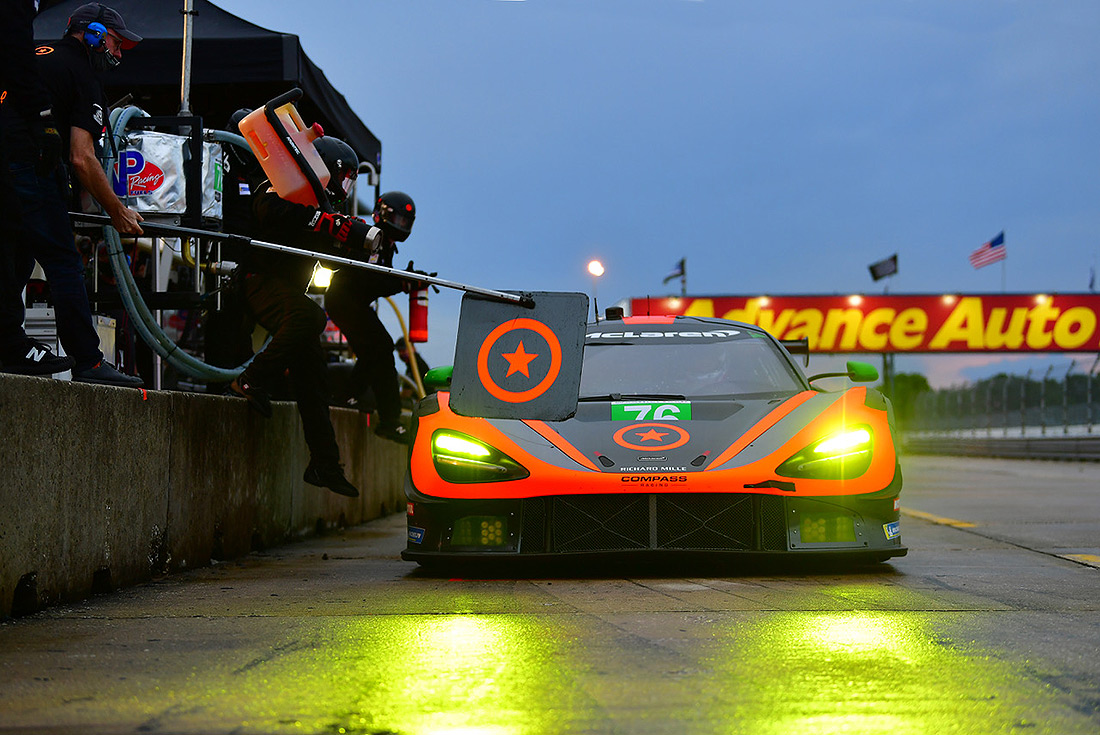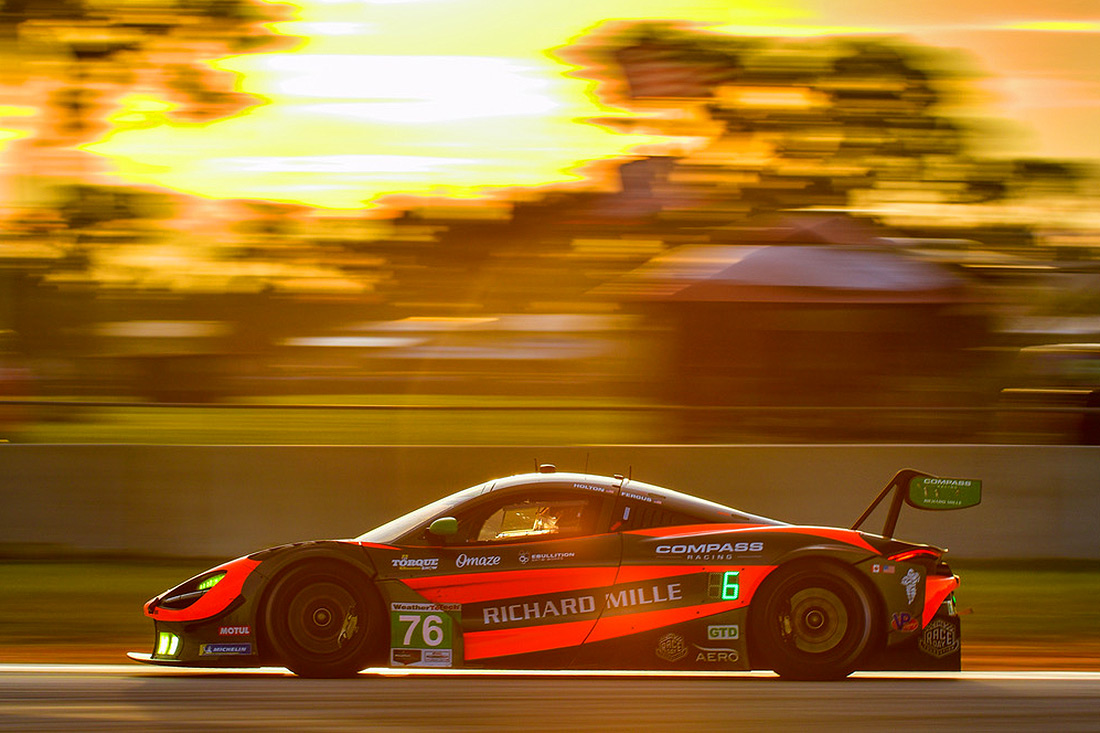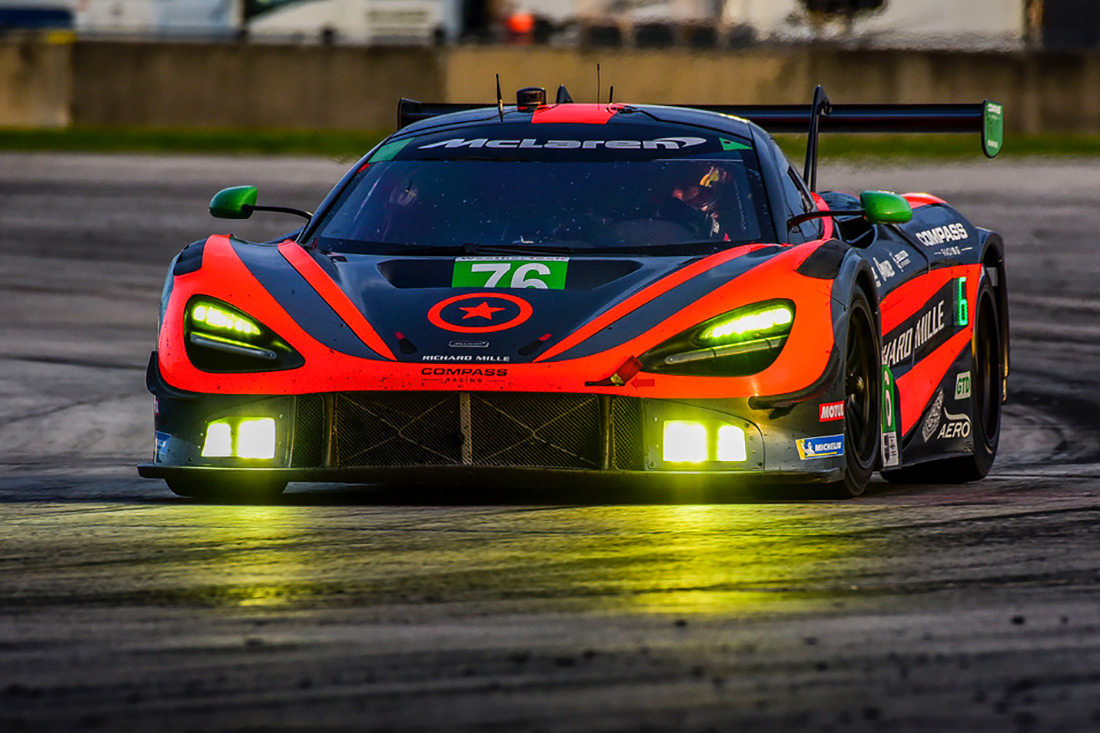GTWC America Acura NSX GT3 Evo

- Matt McMurry
- Rodrigo Sales
- Michael Di Meo
- Ashton Harrison
- Mario Farnbacher
 Although Compass Racing’s No. 76 McLaren 720S GT3 finished well down the points – in 11th – at the season-opening WeatherTech Sprint Cup round at Daytona International Speedway, our car showed strong pace, with Corey Fergus taking pole position, and both he and co-driver Paul Holton setting second-fastest laps during their stints. Our rolling 20-lap averages were also towards the front of the field, and this resulted in IMSA decreeing a rather substantial decrease in performance to our Richard Mille-sponsored entry for the second round, at Sebring.
Although Compass Racing’s No. 76 McLaren 720S GT3 finished well down the points – in 11th – at the season-opening WeatherTech Sprint Cup round at Daytona International Speedway, our car showed strong pace, with Corey Fergus taking pole position, and both he and co-driver Paul Holton setting second-fastest laps during their stints. Our rolling 20-lap averages were also towards the front of the field, and this resulted in IMSA decreeing a rather substantial decrease in performance to our Richard Mille-sponsored entry for the second round, at Sebring.
 In the unsettled weather of first Sebring practice, Holton was able to turn the fastest lap, and as we knew our dry performance was sub-optimal, we kept scanning the skies on race day, watching hopefully for dark black clouds. Qualifying was dry and Fergus put together a perfect lap, wringing the McLaren’s neck and managing a fifth place grid position. We were actually reasonably happy with that, given that the Lexus’, which were first and second, were a full second up the road from P3, with us a few tenths behind P4. So, single-lap pace was close to the non-Lexus cars, but how would the longer stints go?
In the unsettled weather of first Sebring practice, Holton was able to turn the fastest lap, and as we knew our dry performance was sub-optimal, we kept scanning the skies on race day, watching hopefully for dark black clouds. Qualifying was dry and Fergus put together a perfect lap, wringing the McLaren’s neck and managing a fifth place grid position. We were actually reasonably happy with that, given that the Lexus’, which were first and second, were a full second up the road from P3, with us a few tenths behind P4. So, single-lap pace was close to the non-Lexus cars, but how would the longer stints go?
 Although rain did threaten – typical of south Florida in summer time – the green flag fell on a dry track. Corey lost a position to sixth and took up station there as the leaders took off. With the weight added post-Daytona, tire wear was a real concern, as was fuel consumption, so conversation was important while not losing ground. That’s a tall order. A yellow flag came out at about 25 minutes in to the race, and we took the opportunity to pit for fuel and four tires. Some other teams opted for two-tire stops, which dropped No. 76 back to ninth at the re-start with us taking four slicks. Corey made up a few places before handing driving duties over to Holton with just under an hour-and-a-half to go.
Although rain did threaten – typical of south Florida in summer time – the green flag fell on a dry track. Corey lost a position to sixth and took up station there as the leaders took off. With the weight added post-Daytona, tire wear was a real concern, as was fuel consumption, so conversation was important while not losing ground. That’s a tall order. A yellow flag came out at about 25 minutes in to the race, and we took the opportunity to pit for fuel and four tires. Some other teams opted for two-tire stops, which dropped No. 76 back to ninth at the re-start with us taking four slicks. Corey made up a few places before handing driving duties over to Holton with just under an hour-and-a-half to go.
 Holton maintained sixth place through his stint and ensuing pit stops, with the leaders pulling away each lap. The changes IMSA made to our 720S GT3 meant that we simply couldn’t contend with the leading five cars, who finished within a very close 15 seconds of each other. Our car, on the other hand, took the checkered flag 58 seconds back. In a field as closely contested as IMSA’s GTD class, changes in Balance of Performance to the cars can make an enormous difference, and this was borne out at Sebring.
Holton maintained sixth place through his stint and ensuing pit stops, with the leaders pulling away each lap. The changes IMSA made to our 720S GT3 meant that we simply couldn’t contend with the leading five cars, who finished within a very close 15 seconds of each other. Our car, on the other hand, took the checkered flag 58 seconds back. In a field as closely contested as IMSA’s GTD class, changes in Balance of Performance to the cars can make an enormous difference, and this was borne out at Sebring.
 We’re obviously tremendously disappointed. Our drivers helmed the car with precision, our crew executed quick pit stops, and our car performed flawlessly. IMSA is a unique series, in that a new car platform spends its first season demonstrating its capacity and providing the series with data which allows them to properly Balance the car’s Performance versus its competitors. Essentially, you start out heavily restricted and gradually earn the right to be competitive. We did that in 2019, and after fruitful off-season testing felt confident in our McLaren package, and this was borne out by our performance at Daytona. IMSA also offers what we firmly believe is the most competitive GT3-based series in the world. Winning in GTD is truly meaningful.
We’re obviously tremendously disappointed. Our drivers helmed the car with precision, our crew executed quick pit stops, and our car performed flawlessly. IMSA is a unique series, in that a new car platform spends its first season demonstrating its capacity and providing the series with data which allows them to properly Balance the car’s Performance versus its competitors. Essentially, you start out heavily restricted and gradually earn the right to be competitive. We did that in 2019, and after fruitful off-season testing felt confident in our McLaren package, and this was borne out by our performance at Daytona. IMSA also offers what we firmly believe is the most competitive GT3-based series in the world. Winning in GTD is truly meaningful.
 In our opinion, IMSA simply got the BoP wrong on our car for Sebring, a track we had not previously competed at, and one for which they had no data. We’re hopeful this will be set right for our next event, in two weeks, at Road America, where we did race last year. With only seven rounds scheduled for the Coronavirus-shortened Sprint Cup schedule, every race counts, and we’re ready to win.
In our opinion, IMSA simply got the BoP wrong on our car for Sebring, a track we had not previously competed at, and one for which they had no data. We’re hopeful this will be set right for our next event, in two weeks, at Road America, where we did race last year. With only seven rounds scheduled for the Coronavirus-shortened Sprint Cup schedule, every race counts, and we’re ready to win.
— Karl Thomson, Team Principal
